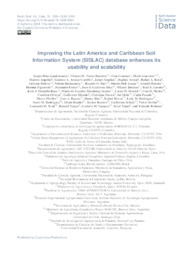Improving the Latin America and Caribbean Soil Information System (SISLAC) database enhances its usability and scalability
Improving the Latin America and Caribbean Soil Information System (SISLAC) database enhances its usability and scalability
Autoria: DÍAZ-GUADARRAMA, S.; VARÓN-RAMÍREZ, V. M.; LIZARAZO, I.; GUEVARA, M.; ANGELINI, M.; ARAUJO-CARRILLO, G. A.; ARGEÑAL, J.; ARMAS, D.; BALTA, R. A.; BOLIVAR, A.; BUSTAMANTE, N.; DART, R. de O.; DELL AQUA, M.; ENCINA, A.; FIGUEREDO, H.; FONTES, F.; GUTIÉRREZ-DIAZ, J. S.; JIMÉNEZ, W.; LAVADO, R. S.; BACA, J. F. M.; MENDONÇA-SANTOS, M. de L.; MORETTI, L. M.; MUÑOZ, I. D.; OLIVERA, C.; OLMEDO, G.; OMUTO, C.; ORTIZ, S.; PASCALE, C.; PFEIFFER, M.; RAMOS, I. A.; RÍOS, D.; RIVERA, R.; RODRÍGUEZ, L. M.; RODRÍGUEZ, D. M.; ROSALES, A.; ROSALES, K.; SCHULZ, G.; SEVILLA, V.; TENTI, L. M.; VARGAS, R.; VASQUES, G. M.; YIGINI, Y.; RUBIANO, Y.
Resumo: Spatial soil databases can help model complex phenomena in which soils are a decisive factor – for example, evaluating agricultural potential or estimating carbon storage capacity. The Latin America and Caribbean Soil Information System, SISLAC, is a regional initiative promoted by the Food and Agriculture Organization’s (FAO) Latin America and the Caribbean Soil Partnership to contribute to sustainable management of soil. SISLAC includes data from 49 084 soil profiles distributed unevenly across the continent, making it the region’s largest soil database. In addition, there are other soil databases in the region with about 40 000 soil profiles that can be integrated into SISLAC and improve it. However, some problems hinder its usages, such as the quality of the data and their high dimensionality. The objective of this research is evaluate the quality of the SISLAC data and the other available soil databases to generate a new improved version that meets the minimum quality requirements to be used for different purposes or practical applications. The results show that 15 % of the existing soil profiles had an inaccurate description of the diagnostic horizons and 17 % of the additional profiles already existed in SISLAC; therefore, a total of 32 % of profiles were excluded for these two reasons. Further correction of an additional 4.5 % of existing inconsistencies improved overall data quality. The improved database consists of 66 746 profiles and is available for public use at https://doi.org/10.5281/zenodo.7876731 (Díaz-Guadarrama and Guevara, 2023). This revised version of SISLAC data offers the opportunity to generate information that helps decision-making on issues in which soils are a decisive factor. It can also be used to plan future soil surveys in areas with low density or where updated information is required.
Ano de publicação: 2024
Tipo de publicação: Artigo de periódico
Unidade: Embrapa Solos
Observações
1 - Por padrão são exibidas publicações dos últimos 20 anos. Para encontrar publicações mais antigas, configure o filtro ano de publicação, colocando o ano a partir do qual você deseja encontrar publicações. O filtro está na coluna da esquerda na busca acima.
2 - Para ler algumas publicações da Embrapa (apenas as que estão em formato ePub), é necessário ter, no celular ou computador, um desses softwares gratuitos. Sistemas Android: Google Play Livros; IOS: iBooks; Windows e Linux: software Calibre.
Acesse outras publicações
Acesse a Base de Dados da Pesquisa Agropecuária (BDPA) para consultar o acervo completo das bibliotecas da Embrapa.

